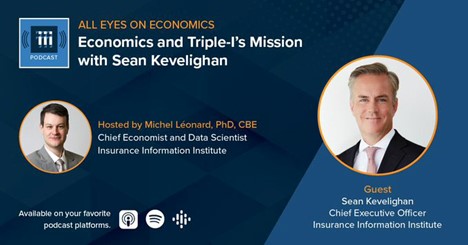
By Lewis Nibbelin, Guest Blogger for Triple-I
Insurance coverage has long been “a grudge purchase – a once-or-twice-a-year transaction that many consumers didn’t want to think about,” Triple-I CEO Sean Kevelighan said in a recent episode of the “All Eyes on Economics” podcast.
But in today’s dynamic economic environment – marked by inflation the likes of which most insurance purchasers have never experienced – it has become more important than ever for consumers and policymakers to understand how insurance is underwritten and priced.
One of Triple-I’s chief objectives is “helping people understand what insurance can do for you, but also what you can do to change the situation,” Kevelighan told podcast host and Triple-I Chief Economist and Data Scientist Michel Léonard. “The narrative seems, at least from my standpoint, to be less about, ‘Why is my insurance so high?’ It’s more about, ‘What can we do to get it lower?’”
Rising insurance premium rates are the effect of risk levels, loss costs, and economic considerations like inflation. Too often, though, they’re discussed as if they were the cause.
High property/casualty premium rates are the result of numerous coalescing factors: Increased litigation, inflation, antiquated state regulations, losses from natural catastrophes, and pervasive post-pandemic high-risk behaviors, to name a few.
Every dollar invested in disaster resilience could save 13 in property damage, remediation, and economic impact costs, according to a recent joint report from Allstate and the U.S. Chamber of Commerce. As areas vulnerable to climate disasters become increasingly populated, it’s important for policyholders to develop resilience measures against the wildfire, hurricane, severe convective storm, and flood risks their property faces.
Consumer education and community involvement in mitigation and resilience offer a path toward greater control over claims.
However, regulatory barriers to fair, accurate underwriting also contribute to higher insurance costs. Despite tort reforms, rampant litigation has kept upward pressure on rates in Florida and Louisiana. California’s outdated Proposition 103 – by barring insurers from using modeling to price risk prospectively and from taking reinsurance costs into account when setting rates – has impeded insurers from using actuarially sound insurance pricing.
Confusion around industry practices and effective mitigation is understandable, and during periods of economic instability and unforeseen disasters, blaming the insurance industry may seem the most direct way to regain control.
But rising rates are “not just an insurance problem,” Kevelighan said. “It’s a risk problem, and we all play a role in addressing that risk.”
The full interview is available now on Spotify, Audible, and Apple.

